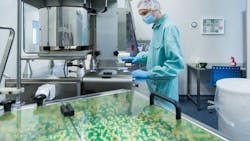Three trends driving automation in pharmaceutical manufacturing
The last few years have been tumultuous ones for the pharmaceutical industry. COVID-19 exerted intense pressures, from the incredibly fast development of vaccines and therapeutics, to supply chain and labor issues that have impacted manufacturing everywhere. At the same time, long-term shifts are taking place in drug delivery and consumer expectations, all of which are requiring pharma manufacturers to adapt.
One key manifestation of these changes is the push to automate manufacturing processes. Automation and digitization were growing trends before the pandemic, but new market conditions have accelerated these developments. Specifically, three factors are driving greater automation in pharma production: ongoing labor issues, the need for increased machine flexibility, and technological advancements to improve product safety. Each plays a role in the increased adoption of automated solutions.
Meeting needs for workers
Labor shortages—comprising both high- and low-skilled workers—were a problem for manufacturers before the pandemic, but as all producers know, they’ve worsened significantly in the last two years. In a 2022 white paper by PMMI, the Association for Packaging and Processing Technologies, 33% of pharmaceutical companies surveyed said they’re still struggling to staff their operations, and labor was listed as the number two challenge for pharma manufacturers in 2023.
Simply put, robots and automated solutions can fill the gaps in pharma producers’ workforces. As Precision Automation notes, robots can perform at greater speeds than humans alone and can handle 24-hour production cycles. Automated solutions are therefore an immediate stopgap measure to address an overall lack of employees, but their productivity is also why companies are planning to increase usage of these solutions.
Why flexible machinery is vital
In PMMI’s industry white paper, 75% of pharmaceutical companies interviewed directly said they expect to increase their usage of automated solutions. In addition to labor shortages, another major factor driving this is the shift toward injectables and more personalized medications. For example, the injectables segment has seen nearly 100% growth since 2016, and parenteral containers are expected to grow at a CAGR of 7.6% to 2027.
Personalized dosages and items like pre-filled syringes are challenging pharma production lines. As PMMI’s report explains, “The end result is that manufacturing professionals are looking for machines that are able to handle the wider variety of formats being produced in smaller batch runs, while still minimizing downtime.”
A larger number of formats and sizes means machinery must be flexible and able to accommodate frequent changeovers, and automated solutions facilitate these processes. At the same time, direct-to-consumer (DTC) shipping has exploded with the growth of e-commerce in recent years, and packaging and labeling must evolve to get medications safely and effectively to patients. All of these market conditions call for fast, flexible machinery that can be modified with relative ease, and robots and automated solutions are often the most reliable solutions to these challenges.
Advances in production safety
New delivery options and medication formats also present safety challenges for pharma producers. For example, PMMI’s white paper notes that “packages in the DTC channel are handled much more frequently than products shipped through traditional bulk channels, resulting in overall rougher handling and increased chance of packaging or product damage.” The growth of injectables has also placed greater emphasis on sterility—the nature of these drugs and injection delivery means sanitary production is absolutely critical. For both of these types of challenges, automated solutions, particularly those powered by artificial intelligence, can improve product safety.
AI-supported vision inspections can more quickly and accurately spot packaging defects. These tools can also look for issues such as glass vials flaking into liquid medications, which is a concern with certain injectable drugs. Limiting human interaction with production overall can improve sanitary conditions, and as robots with washdown capabilities become more common, these tools can improve safety and sterility all along the pharma production line.
Finding solutions with industry partners
With all of these forces driving changes in pharmaceutical manufacturing, producers can and should look to automation to ease labor shortages, facilitate more flexible machine runs, and improve product safety. Fortunately, the industry is coming together in person again to share insights and innovations, and the best place to do that is PACK EXPO International (Oct. 23-26, 2022; McCormick Place, Chicago)—the most comprehensive packaging and processing show in the world in 2022.
From connecting with colleagues and hearing from experts to seeing new technologies, materials, and machinery-in-action, PACK EXPO International is the most efficient and effective way to discover packaging and processing solutions for over 40 vertical markets, and the Healthcare Packaging Pavilion will focus specifically on the life sciences market. No other event this year will showcase entire production line solutions and offer attendees everything needed to compete in a changing marketplace. For more information and to register, visit packexpointernational.com.
About the Author
Jorge Izquierdo
vice president, Market Development, PMMI, The Association for Packaging and Processing Technologies
Jorge Izquierdo is vice president, Market Development, for PMMI, The Association for Packaging and Processing Technologies
